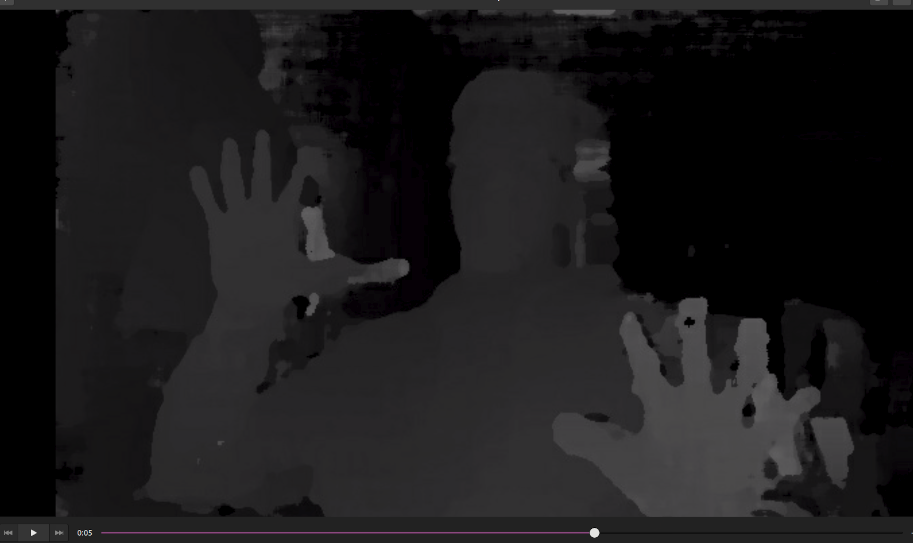Disparity encoding¶
This example encodes disparity output of the StereoDepth. Note that you shouldn’t enable subpixel mode, as UINT16 isn’t supported by the VideoEncoder.
Pressing Ctrl+C will stop the recording and then convert it using ffmpeg into an mp4 to make it playable. Note that ffmpeg will need to be installed and runnable for the conversion to mp4 to succeed.
Be careful, this example saves encoded video to your host storage. So if you leave it running, you could fill up your storage on your host.
Similar samples:
Encoded bitstream (either MJPEG, H264, or H265) from the device can also be saved directly into .mp4 container with no computational overhead on the host computer. See demo here for more information.
Matroska
Besides ffmpeg and .mp4 video container (which is patent encumbered), you could also use the mkvmerge
(see MKVToolNix for GUI usage) and .mkv video container
to mux encoded stream into video file that is supported by all major video players
(eg. VLC)
mkvmerge -o vid.mkv video.h265
Demo¶

Setup¶
Please run the install script to download all required dependencies. Please note that this script must be ran from git context, so you have to download the depthai-python repository first and then run the script
git clone https://github.com/luxonis/depthai-python.git
cd depthai-python/examples
python3 install_requirements.py
For additional information, please follow installation guide
Source code¶
Also available on GitHub
1 2 3 4 5 6 7 8 9 10 11 12 13 14 15 16 17 18 19 20 21 22 23 24 25 26 27 28 29 30 31 32 33 34 35 36 37 38 39 40 41 42 43 44 45 46 47 48 49 50 51 52 53 54 55 56 | #!/usr/bin/env python3
import depthai as dai
# NOTE Because we are encoding disparity values, output video will be a gray, and won't have many pixel levels - either 0..95 or 0..190
# Create pipeline
pipeline = dai.Pipeline()
# Create left/right mono cameras for Stereo depth
monoLeft = pipeline.create(dai.node.MonoCamera)
monoLeft.setResolution(dai.MonoCameraProperties.SensorResolution.THE_400_P)
monoLeft.setCamera("left")
monoRight = pipeline.create(dai.node.MonoCamera)
monoRight.setResolution(dai.MonoCameraProperties.SensorResolution.THE_400_P)
monoRight.setCamera("right")
# Create a node that will produce the depth map
depth = pipeline.create(dai.node.StereoDepth)
depth.setDefaultProfilePreset(dai.node.StereoDepth.PresetMode.HIGH_DENSITY)
depth.initialConfig.setMedianFilter(dai.MedianFilter.KERNEL_7x7)
depth.setLeftRightCheck(False)
depth.setExtendedDisparity(False)
# Subpixel disparity is of UINT16 format, which is unsupported by VideoEncoder
depth.setSubpixel(False)
monoLeft.out.link(depth.left)
monoRight.out.link(depth.right)
videoEnc = pipeline.create(dai.node.VideoEncoder)
# Depth resolution/FPS will be the same as mono resolution/FPS
videoEnc.setDefaultProfilePreset(monoLeft.getFps(), dai.VideoEncoderProperties.Profile.MJPEG)
depth.disparity.link(videoEnc.input)
xout = pipeline.create(dai.node.XLinkOut)
xout.setStreamName("enc")
videoEnc.bitstream.link(xout.input)
# Connect to device and start pipeline
with dai.Device(pipeline) as device:
# Output queue will be used to get the encoded data from the output defined above
q = device.getOutputQueue(name="enc")
# The .h265 file is a raw stream file (not playable yet)
with open('disparity.mjpeg', 'wb') as videoFile:
print("Press Ctrl+C to stop encoding...")
try:
while True:
videoFile.write(q.get().getData())
except KeyboardInterrupt:
# Keyboard interrupt (Ctrl + C) detected
pass
print("To view the encoded data, convert the stream file (.mjpeg) into a video file (.mp4) using a command below:")
print("ffmpeg -framerate 30 -i disparity.mjpeg -c copy video.mp4")
|
Also available on GitHub
1 2 3 4 5 6 7 8 9 10 11 12 13 14 15 16 17 18 19 20 21 22 23 24 25 26 27 28 29 30 31 32 33 34 35 36 37 38 39 40 41 42 43 44 45 46 47 48 49 50 51 52 53 54 55 56 57 58 59 60 61 62 63 | #include <csignal>
#include <iostream>
// Includes common necessary includes for development using depthai library
#include "depthai/depthai.hpp"
static std::atomic<bool> alive{true};
static void sigintHandler(int signum) {
alive = false;
}
int main() {
using namespace std;
std::signal(SIGINT, &sigintHandler);
// Create pipeline
dai::Pipeline pipeline;
// Define sources and outputs
auto monoLeft = pipeline.create<dai::node::MonoCamera>();
monoLeft->setResolution(dai::MonoCameraProperties::SensorResolution::THE_400_P);
monoLeft->setCamera("left");
auto monoRight = pipeline.create<dai::node::MonoCamera>();
monoRight->setResolution(dai::MonoCameraProperties::SensorResolution::THE_400_P);
monoRight->setCamera("right");
auto stereo = pipeline.create<dai::node::StereoDepth>();
stereo->setDefaultProfilePreset(dai::node::StereoDepth::PresetMode::HIGH_DENSITY);
stereo->initialConfig.setMedianFilter(dai::MedianFilter::KERNEL_7x7);
stereo->setLeftRightCheck(false);
stereo->setExtendedDisparity(false);
// Subpixel disparity is of UINT16 format, which is unsupported by VideoEncoder
stereo->setSubpixel(false);
monoLeft->out.link(stereo->left);
monoRight->out.link(stereo->right);
auto videoEnc = pipeline.create<dai::node::VideoEncoder>();
videoEnc->setDefaultProfilePreset(monoLeft->getFps(), dai::VideoEncoderProperties::Profile::MJPEG);
stereo->disparity.link(videoEnc->input);
auto xout = pipeline.create<dai::node::XLinkOut>();
xout->setStreamName("disparity");
videoEnc->bitstream.link(xout->input);
// Connect to device and start pipeline
dai::Device device(pipeline);
// Output queue will be used to get the disparity frames from the outputs defined above
auto q = device.getOutputQueue("disparity");
auto videoFile = std::ofstream("disparity.mjpeg", std::ios::binary);
cout << "Press Ctrl+C to stop encoding..." << endl;
while(alive) {
auto h265Packet = q->get<dai::ImgFrame>();
videoFile.write((char*)(h265Packet->getData().data()), h265Packet->getData().size());
}
cout << "To view the encoded data, convert the stream file (.mjpeg) into a video file (.mp4) using a command below:" << endl;
cout << "ffmpeg -framerate 30 -i disparity.mjpeg -c copy video.mp4" << endl;
return 0;
}
|